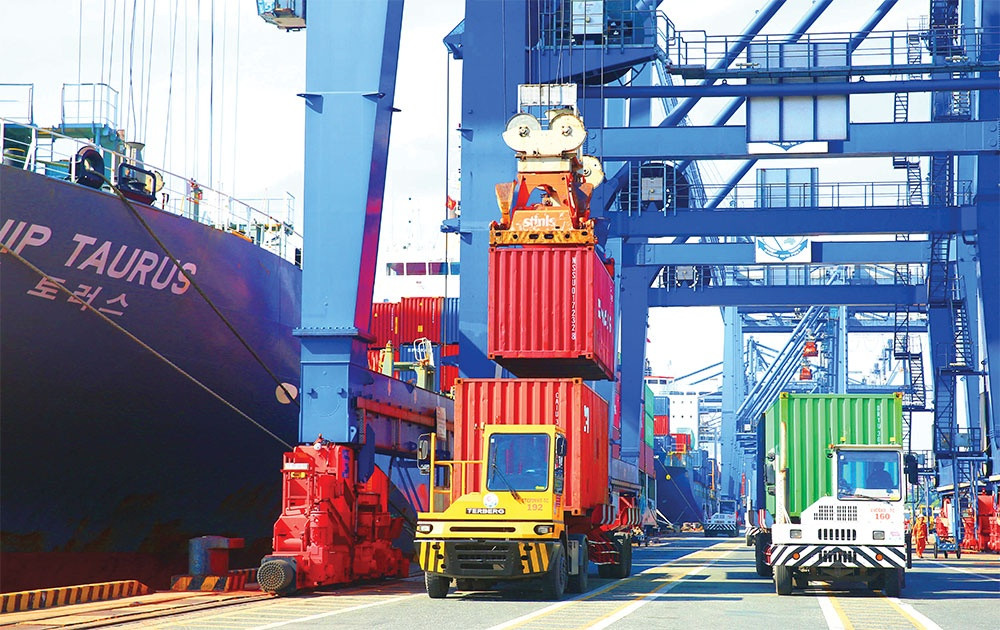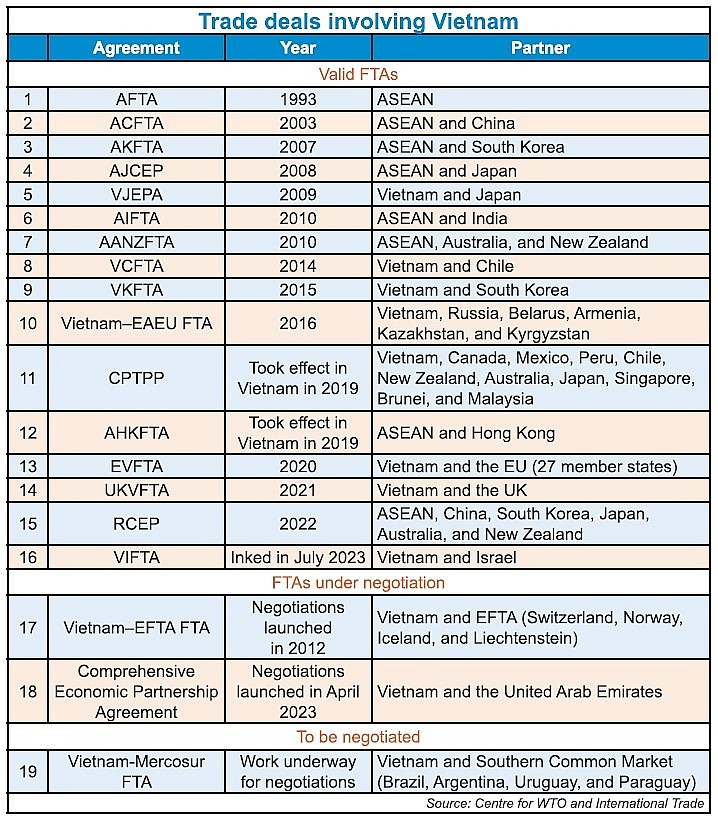 |
The Ministry of Industry and Trade (MoIT) this month underlined the urgent need for Vietnam to expand export markets to take advantage of economic links due to a seven-month reduction of exports and imports, and in order to enhance national economic status in the international arena.
In the first seven months of this year, Vietnam’s total goods export and import turnover is estimated to be $374.23 billion – down 13.9 per cent on-year “due to colossal difficulties in the global market”, according to the MoIT.
This includes $194.73 billion worth of exports, down 10.6 per cent; and $179.5 billion for imports, down 17.1 per cent. Total trade surplus hit $15.23 billion, which is over 11 times higher than that of $1.34 billion in the same period last year.
The MoIT earlier set a target of $775 billion in total goods export-import revenue this year – up by 6 per cent from 2022. This includes $394 billion for exports and $381 billion for imports, with a trade surplus of $13 billion.
“To expand export markets, we need to boost the negotiations and inking of new free trade agreements (FTAs) and economic links, including the early implementation of the Vietnam-Israel FTA (VIFTA), and signing deals with the United Arab Emirates and the Southern Common Market (Mercosur),” said MoIT Deputy Minister Phan Thi Thang. “This is aimed to diversify our export markets, products, and supply chains.”
She also underscored advantages for Vietnam to materialise these goals.
Vietnam is playing an increasing role in ASEAN, which has become an influential pivot for the world’s market regions, and an increasingly important market for many nations’ foreign and economic policies such as the EU’s Indo-Pacific Strategy, the US’ Indo-Pacific Economic Framework for Prosperity, and the UK’s upcoming membership of the Comprehensive and Progressive Agreement for Trans-Pacific Partnership.
“This will make it favourable for Vietnam’s investment attraction and trade expansion,” Thang stressed.
Intensifying integration
According to the MoIT, authorised agencies have been assigned to work with peers of Mercosur – Brazil, Argentina, Uruguay, and Paraguay – on the negotiations of a bilateral FTA in a bid to swell trade and investment ties with this bloc.
Currently, Vietnam has completed an internal review on the negotiations, hoping that the two sides will soon start negotiations later this year or early next year.
Mercosur is a high potential market for various Vietnamese key consumer goods such as telephones, mobile phones and parts, electrical products, garments and textiles, and footwear, said the MoIT.
Meanwhile, Vietnam and the UAE are negotiating the bilateral Comprehensive Economic Partnership Agreement, expected to be clinched later this year, when both countries celebrate 30 years of bilateral diplomatic ties.
Under statistics of the UAE, the import-export turnover between the two nations reached $8.7 billion last year, accounting for 30 per cent of the total trade exchange between the UAE and ASEAN.
Meanwhile, in order to implement the VIFTA which was signed in late July and will be adopted by the legislatures of Vietnam and Israel, both nations will launch a direct air route in late September, expected to help raise investment and trade ties. Total trade turnover hit $2.2 billion last year and $1.68 billion in the first seven months of this year. In addition, Vietnam has also been negotiating an FTA with the European Free Trade Association members of Switzerland, Norway, Iceland, and Liechtenstein.

Greater benefits
Starting with the participation in ASEAN and its trade agreement in 1995, Vietnam has been actively engaging further in bilateral and regional trade deals with major economies (see table).
Thanks to such international economic integration over the years, Vietnam’s economy has increased 1.4 times in scale within five years, becoming the fourth-largest economy in ASEAN, and ranking 37th worldwide.
According to the World Bank, Vietnam has been a development success story. Economic reforms since the mid-1980s, coupled with beneficial global trends, have helped propel Vietnam from being one of the world’s poorest nations to a middle-income economy in one generation.
Between 2002 and 2021, GDP per capita increased 3.6 times, reaching almost $3,700. Poverty rates declined from 14 per cent in 2010 to 3.8 per cent in 2020.
Thanks to its solid foundations, the economy has proven resilient through different crises. GDP growth is projected to ease to 4.7 per cent in 2023 down from 8.02 per cent in 2022, due to the moderation of domestic demand and exports. Vietnam’s economic growth is expected to gradually accelerate to 5.5 per cent in 2024 and 6 per cent in 2025. This will be further supported by the accelerating recovery of its main export markets such as the US, the Eurozone, and China.
Total trade turnover soared from $157.1 billion in 2010 to $668.5 billion last year, according to the MoIT.
The Ministry of Planning and Investment reported that total registered foreign direct investment into Vietnam reached $452.7 billion as of July 20. In the January-July 20 period, total newly registered and newly added capital and capital contributions and stake acquisitions hit $16.24 billion, up 4.5 per cent on-year.
“International economic integration has earned Vietnam much investment from overseas. Foreign-invested enterprises have been playing a very important role in the national socioeconomic development.” said economic expert Nguyen Mai. “Specifically, they have been providing employment for 4.5 million direct local labourers and millions of indirect labourers. They hold 23-25 per cent of total national development investment capital, and create more than half of industrial gross output, while helping the country develop a modern financial and banking system.”
“They also hold 70 per cent of the nation’s total export turnover, and are responsible for 20 per cent of state budget and 20 per cent of GDP,” Mai continued.
Dorsati Madani, senior country economist at the World Bank in Vietnam last week said that Vietnam in the long term will continue to be an attractive destination for investors.
“Even during the pandemic, foreign investment still entered the country. Now when conditions are changing very fast, investors still enter Vietnam in a higher number than other nations thanks to Vietnam’s political stability and improved business and investment climate,” Madani said.
Source: VIR